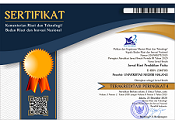Pembelajaran Interactive Demonstration dengan Diagram Gaya melalui Real dan Virtual Lab untuk Meningkatkan Pemahaman Konsep Dinamika Rotasi
Abstract
Keywords
Full Text:
PDFReferences
Sutopo, “Students’ Understanding of Fundamental Cocepts of Mechanical Wave,” J. Pendidik. Fis. Indones., vol. 12, pp. 41–53, 2016.
J. L. Docktor and J. P. Mestre, “A Synthesis of Discipline-Based Education Research in Physics,” Phys. Rev. Spec. Top. - Phys. Educ. Res., vol. 10, no. 2, pp. 1–148, 2014.
B. Hegde and B. N. Meera, “How Do They Solve It? An Insight into The Learner’s Approach to the Mechanism of Physics Problem Solving,” Phys. Rev. Spec. Top. - Phys. Educ. Res., vol. 8, no. 1, pp. 1–9, 2012.
M. Lopez, “Angular and Linear Acceleration in A Rigid Rolling Body: Student's,” Eur. J. Phys., vol. 24, pp. 553–562, 2003.
L. G. Rimoldini and C. Singh, “Student Understanding of Rotational and Rolling Motion Concepts,” Phys. Rev. Spec. Top. - Phys. Educ. Res., vol. 1, no. 1, pp. 1–9, 2005.
I. Duman, N. Demirci, and A. Sekercioglu, “University Students’ Difficulties and Misconceptions on Rolling, Rotational Motion, and Torque Concepts,” Int. J. New Trends Educ. Their Implic., vol. 6, pp. 46–54, 2015.
N. Khasanah, W. Wartono, and L. Yuliati, “Analysis of Mental Model of Students using Isomorphic Problems in Dynamics of Rotational Motion Topic,” J. Pendidik. IPA Indones., vol. 5, no. 2, pp. 186–191, 2016.
D. Sarkity, L. Yuliati, and A. Hidayat, “Kesulitan Siswa SMA dalam Memecahkan Masalah Kesetimbangan dan Dinamika Rotasi,” in Prosiding Semnas Pendidikan IPA Pascasarjana UM, vol. 1, 2016.
G. C. Adam et al., “Misconceptions in Rolling Dynamics. A Case Study of an Inquiry Based Learning Activity,” in ASEE 123nd Annual Conference, New Orleans, 2016.
O. D. Pranata, L. Yuliati, and D. Wartono, “Concept Acquisition of Rotational Dynamics by Interactive Demonstration and Free-Body Diagram,” J. Educ. Learn., vol. 11, no. 3, p. 291, 2017.
Permendikbud, Salinan Lampiran Peraturan Menteri Pendidikan dan Kebudayaan Nomor 21 Tahun 2016 tentang Standar Isi Pendidikan Dasar dan Menengah, 2016.
D. Rohendi, H. Sutarno, and M. A. Ginanjar, “Efektivitas Metode Pembelajaran Demonstrasi terhadap Peningkatan Hasil Belajar Siswa Kelas X pada Mata Pelajaran Keterampilan Komputer dan Pengelolaan Informasi Di Sekolah Menengah Kejuruan,” J. PTIK, vol. 3, no. 1, pp. 16–18, 2010.
C. J. Wenning, “The Levels of Inquiry Model of Science Teaching,” Journal of Physics Teacher Education, vol. 6, no. 2, pp. 9–16, 2011.
I. Wijaya, I. Kirna, and I. Suardana, “Model Demonstrasi Interaktif Berbantuan Multimedia dan Hasil Belajar IPA Aspek Kimia Siswa SMP,” J. Pendidik. dan Pengajaran, vol. No. 1, pp. 88–98, 2012.
M. N. R. Jauhariyah, Z. Zaitul, and M. Indina, “Learn Physics Using Interactive Demonstration to Reduce The Students’ Misconceptions on Mechanical Wave,” In Mathematics, Informatics, Science, and Education International Conference (MISEIC 2018), Atlantis Press, 2018.
F. N. Annisa, S. Karim, and A. Aminudin, “Penerapan Metode Pembelajaran Demonstrasi Interaktif untuk Meningkatkan Hasil Belajar Fisika Siswa SMA pada Konsep Suhu dan Kalor,” J. Pengajaran Mat. dan Ilmu Pengetah. Alam, vol. 19, no. 1, p. 88, 2014.
M. Faour and Z. Ayoubi, “The Effect of Using Virtual Laboratory on Grade 10 Students’ Conceptual Understanding and Their Attitudes towards Physics,” J. Educ. Sci. Environ. Heal., vol. 4, no. 1, pp. 54–68, 2018.
M. Ramadhan and Irwanto, “Using Virtual Labs to Enhance Students’ Thinking Abilities, Skills, and Scientific Attitudes,” In New Trends in Networking, Computing, E-learning, Systems Sciences, and Engineering, pp. 187–192, Springer, Cham, 2015.
F. Yahya, Hermansyah, and S. Fitriyanto, “Virtual Experiment untuk Meningkatkan Pemahaman Siswa pada Konsep Getaran dan Gelombang,” J. Chem. Inf. Model., vol. 53, no. 9, pp. 1689–1699, 2013.
R. R. Hake, “Interactive-Engagement Versus Traditional Methods: A Six-Thousand-Student Survey of Mechanics Test Data for Introductory Physics Courses,” Am. J. Phys., vol. 66, no. 1, pp. 64–74, 1998.
W. P. Sari, E. Suyanto, and W. Suana, “Analisis Pemahaman Konsep Vektor pada Siswa Sekolah Menengah Atas,” J. Ilm. Pendidik. Fis. Al-Biruni, vol. 6, no. 2, p. 159, 2017.
M. Taqwa and D. Pilendia, “Kekeliruan Memahami Konsep Gaya, Apakah Pasti Miskonsepsi ?,” J. Inov. Pendidik. Fis. dan Integr., vol. 01, no. 02, pp. 1–12, 2018.
DOI: http://dx.doi.org/10.17977/um058v5i1p18-23
Refbacks
- There are currently no refbacks.
Copyright (c) 2020 Diana Eka Saputri, Agus Suyudi
View My Stats
Journal Riset Pendidikan Fisika is indexed by:















